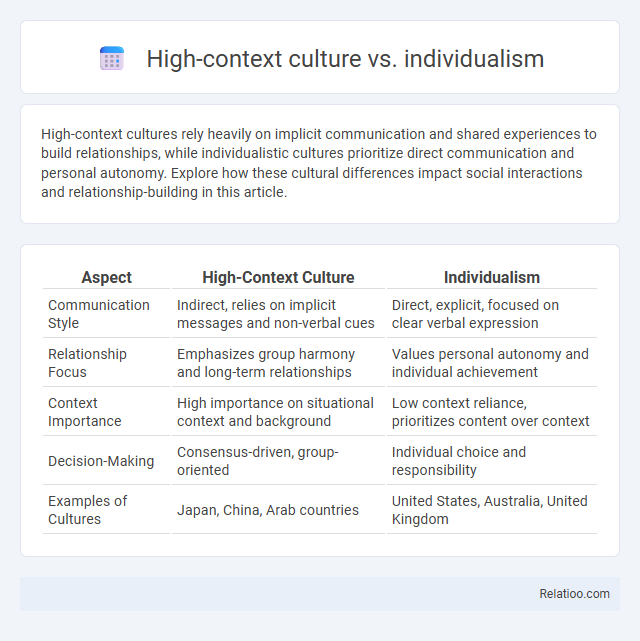High-context cultures rely heavily on implicit communication and shared experiences to build relationships, while individualistic cultures prioritize direct communication and personal autonomy. Explore how these cultural differences impact social interactions and relationship-building in this article.
Table of Comparison
| Aspect | High-Context Culture | Individualism |
|---|---|---|
| Communication Style | Indirect, relies on implicit messages and non-verbal cues | Direct, explicit, focused on clear verbal expression |
| Relationship Focus | Emphasizes group harmony and long-term relationships | Values personal autonomy and individual achievement |
| Context Importance | High importance on situational context and background | Low context reliance, prioritizes content over context |
| Decision-Making | Consensus-driven, group-oriented | Individual choice and responsibility |
| Examples of Cultures | Japan, China, Arab countries | United States, Australia, United Kingdom |
Understanding High-Context Culture
High-context culture relies heavily on implicit communication, shared experiences, and non-verbal cues, which means understanding your social environment and relationships is essential for effective interaction. Unlike individualism, where explicit expressions and personal achievements are prioritized, high-context cultures emphasize group harmony, trust, and collective identity. Recognizing these subtle communication patterns allows you to navigate social complexities and build stronger connections within high-context societies.
Defining Individualism in Society
Individualism in society emphasizes personal autonomy, self-reliance, and individual rights, contrasting sharply with high-context cultures that prioritize group harmony and implicit communication. In individualistic societies, social interactions are direct and explicit, valuing personal achievement over collective goals. This cultural orientation affects social behavior, decision-making processes, and communication styles by fostering independence and personal accountability.
Key Characteristics of High-Context Cultures
High-context cultures rely heavily on implicit communication, nonverbal cues, and shared experiences to convey meaning, making relationships and social harmony essential components. These societies prioritize group cohesion, tradition, and indirect expression, where context and background information shape interactions more than explicit words. Understanding high-context cultures is crucial for effective communication in regions such as East Asia, the Middle East, and Latin America, where collective values often outweigh individual expression.
Major Traits of Individualistic Societies
Individualistic societies prioritize personal autonomy, self-expression, and individual rights over group goals or social roles, often valuing independence and self-reliance. Communication in these cultures tends to be direct and explicit, contrasting with high-context cultures where meaning is derived from context, nonverbal cues, and shared understanding. Major traits include a focus on individual achievement, privacy, and a preference for personal decision-making rather than collective consensus.
Communication Styles: Context vs. Directness
High-context cultures rely heavily on implicit communication, nonverbal cues, and shared understanding, where meaning is derived from context rather than explicit words. Individualism values direct, clear, and explicit communication, emphasizing personal expression and straightforwardness to convey messages. Your ability to navigate these differing communication styles enhances cross-cultural interactions, balancing indirect subtleties with transparent dialogue.
Relationship Dynamics and Social Structures
High-context cultures emphasize nonverbal cues, shared experiences, and deep-rooted relationships to maintain social harmony, while individualism prioritizes personal goals and explicit communication within more flexible social structures. The relationship dynamics in high-context cultures rely heavily on trust and long-term commitments, contrasting with the individualistic preference for directness and independence. Understanding these distinctions can enhance Your ability to navigate diverse social environments effectively.
Conflict Resolution Approaches
High-context cultures rely heavily on implicit communication, valuing harmony and indirect conflict resolution through non-verbal cues and relationship preservation. Individualism emphasizes open, direct dialogue where personal opinions and explicit communication are crucial to resolving conflicts transparently. Understanding these distinct conflict resolution approaches helps you navigate cross-cultural interactions effectively, minimizing misunderstandings and fostering cooperation.
Impact on Workplace and Team Collaboration
High-context cultures rely on implicit communication and strong relationships, which can enhance trust and cohesion in team collaboration but may lead to misunderstandings for those from low-context backgrounds. Individualism emphasizes personal goals and independence, fostering innovation and accountability while potentially challenging collective decision-making and harmony in the workplace. Your success in a diverse team depends on recognizing these cultural differences to balance clear communication with respect for varying collaboration styles.
Cultural Misunderstandings and Adaptation
High-context cultures rely heavily on implicit communication and shared experiences, making direct statements less common, which can lead to misunderstandings with individualistic cultures that prioritize clear, explicit communication and personal expression. You may encounter challenges interpreting nonverbal cues or hidden meanings when interacting with high-context cultures, requiring increased cultural sensitivity and observation to adapt effectively. Developing awareness of these differing communication styles is essential to bridge gaps, reduce conflicts, and enhance cross-cultural collaboration.
Strategies for Bridging Cultural Differences
Strategies for bridging cultural differences between high-context cultures and individualistic societies include fostering open communication that respects implicit messages and non-verbal cues common in high-context settings. Emphasizing cultural awareness training helps individuals recognize differing values around social harmony and personal autonomy, enhancing empathy and reducing misunderstandings. Collaborative problem-solving techniques promote mutual respect by balancing collective goals with individual expression, creating more effective intercultural interactions.

Infographic: High-context culture vs Individualism
 relatioo.com
relatioo.com